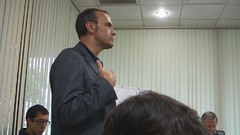I’m always getting a civics lesson, learning more and more about
how our local and state governments work. Most recently, I had
the opportunity to have explained two documents related to the
Lowndes County Comprehensive Plan: the Short Term Work Projects (STWP)
and the Report of Accomplishments (ROA).
In the spirit of information exchange, I share what I learned with you.
The state of Georgia requires a Comprehensive Plan
and collects and approves them through the
Department of Community Affairs (DCA).
The current plans for all of Georgia are available at the
DCA Planning Site.
 The current STWP documents that are being reviewed locally are the projects
that the local governments and agencies expect to actively work on in
the next five years.
The ROA documents report on what was done in the past five years:
what was completed, or will no longer be pursued.
Many municipalities and counties file separate reports.
Locally, because there is significant cooperation among the cities and Lowndes
County there is one document with all the projects included and a place that
indicates which agency is participating in the project.
However, their input documents are filed separately, and LAKE
has collected them
on the LAKE web pages.
Also, each local municipality holds its own public hearings.
The current STWP documents that are being reviewed locally are the projects
that the local governments and agencies expect to actively work on in
the next five years.
The ROA documents report on what was done in the past five years:
what was completed, or will no longer be pursued.
Many municipalities and counties file separate reports.
Locally, because there is significant cooperation among the cities and Lowndes
County there is one document with all the projects included and a place that
indicates which agency is participating in the project.
However, their input documents are filed separately, and LAKE
has collected them
on the LAKE web pages.
Also, each local municipality holds its own public hearings.
Reading the STWP and ROA can be a bit tricky but once I understood the format,
the process became much easier. The overall topics are prescribed by the
state and are in general categories like
“Population”, “Economic Development”, “Housing” and “Land Use”.
There are sub-categories in each of the ten major categories, like
“Secure High-Wage Jobs” and “Address Workforce Adequacy” in the
“Economic Development” major category.
Then, under each of these items are one or more specific projects
that will be done in the next five years to help achieve each goal.
One reason the draft STWP is complex is that it redlines projects that were
performed in the previous five years and are now being removed or modified
for a variety of reasons.
Many projects were completed, some moved from one stage
(investigate) to another (implement or market), and still others
simply lacked the staff or funding resources to continue being pursued.
The ROA document is in a similar format but the focus of it is to report the
status of the STWP for the previous five years.
An Explanation Column gives details on the status of each previous project.
For example, it says that the “Feed the Elderly Senior
Citizen Nutrition Program” has been discontinued because “Budgetary
constraints have limited Lowndes County’s role in this supporting action.”.
The STWP and ROA documents are meant to be read as a pair,
giving the reader an understanding of
where we have been, where we are going and
how we are going to get there as a community.
-gretchen







 Frequent attendees told me the audience was much larger
than in previous years, and one attributed that to the recent
school consolidation referendum.
Sitting side by side were Chamber Chair Tom Gooding and
FVCS President Sam Allen.
Frequent attendees told me the audience was much larger
than in previous years, and one attributed that to the recent
school consolidation referendum.
Sitting side by side were Chamber Chair Tom Gooding and
FVCS President Sam Allen.
 Jeff Hanson introduced the legislators.
He’s the Chair of the Chamber’s
Jeff Hanson introduced the legislators.
He’s the Chair of the Chamber’s
 “Dr. Z” as Tim Golden called him.
“Dr. Z” as Tim Golden called him.



